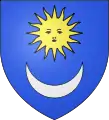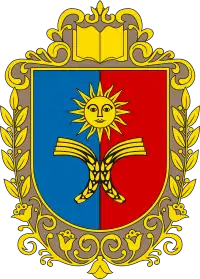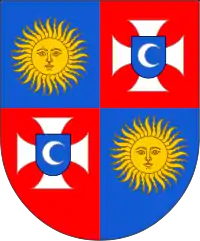Sun (heraldry)
A representation of the sun is used as a heraldic charge. The most usual form, often called sun in splendour or in his glory, consists of a round disc with the features of a human face surrounded by twelve or sixteen rays alternating wavy and straight.[2][3] The alternating straight and wavy rays are often said to represent the light and heat of the sun respectively.[4]



It was used as a badge by Edward II of England, and was later adopted by Edward IV following the appearance of a parhelion or "sun dog" before his victory at the Battle of Mortimer's Cross in 1461.[3][5] It also had significance in alchemy, and may be a symbol of the Roman deity Sol Invictus (Unconquered Sun).[6]
It is a common charge in the heraldry of many countries; e.g. the bearings of Armstrong, Canada, and the arms of Banbury Town Council, England. It also often appears as a rising sun as in the arms of East Devon District Council, England, and as a demi sun as in the coat of Aitchison, Canada.
The Sun of May shown on the national flags of Argentina (1818) and Uruguay (1828) is identical in form to the "Sun in Splendour".
Examples
- Sun in splendour, with face

Arms of Amelot family 

Arms of Arraincourt .svg.png.webp)
Arms of Auzeville-Tolosane 
Arms of Basse-Terre .svg.png.webp)
Arms of Bassurels 
Arms of Creisset 
Arms of Cuba (Portugal) .svg.png.webp)
Arms of Dole (Jura) 
Arms of Écija 
Arms of Ennetbürgen .svg.png.webp)
Arms of Fontaines-Saint-Martin 
Arms of Känerkinden 
Arms of Kamianets-Podilsky 
Arms of Khmelnytskyi Oblast 
Arms of Loukov 
Arms of Mende .svg.png.webp)

Flag of the Philippines (1899-1901) 
Arms of Sankt Gilgen 
Arms of El Soleràs 
Arms of Tarnopol Voivodeship 

Arms of Vědomice 
Arms of Věžky 
Arms of Vinnytsia Oblast 
Arms of Zhytomyr Oblast
- Sun in splendour, without face

Arms of Archena 
Arms of Arosa .svg.png.webp)
Arms of Barbâtre .svg.png.webp)
Arms of La Baule-Escoublac .svg.png.webp)
Flag of the Colorado Party, in the Uruguayan Civil War
- straight rays (mullet)

Arms of Beriáin 
Arms of Dobel 
Arms of Galar 

Flag of Székely Land 
Flag of the Republic of China (Taiwan) 
- wavy rays (estoile)

Arms of the Diocese of Gothenburg 
Arms of Jēkabpils District 

- without rays (roundel)
- other forms

Naval Ensign of Japan 


Flag of the Philippines 

Emblem of the Philippines
References
- English heraldic tradition of the early modern period associates the star and crescent design with Richard, with his victory over Isaac Komnenos of Cyprus in 1192, and with the arms of Portsmouth (Francis Wise A Letter to Dr Mead Concerning Some Antiquities in Berkshire, 1738, p. 18). Heraldic tradition also attributes a star-and-crescent badge to Richard (Charles Fox-Davies, A Complete Guide to Heraldry, 1909, p. 468).
- James Parker, A glossary of terms used in heraldry. Accessed 13 December 2009
- Dictionary of Vexillology. Accessed 13 December 2009
- Fox-Davies, A.C., (1969) A complete guide to heraldry. Aylesbury: Thomas Nelson and Sons. p. 222.
- Encyclopædia Britannica: Edward IV and the Alchemists. Accessed 13 December 2009
- Banbury Faith Trail. Accessed 13 December 2009


